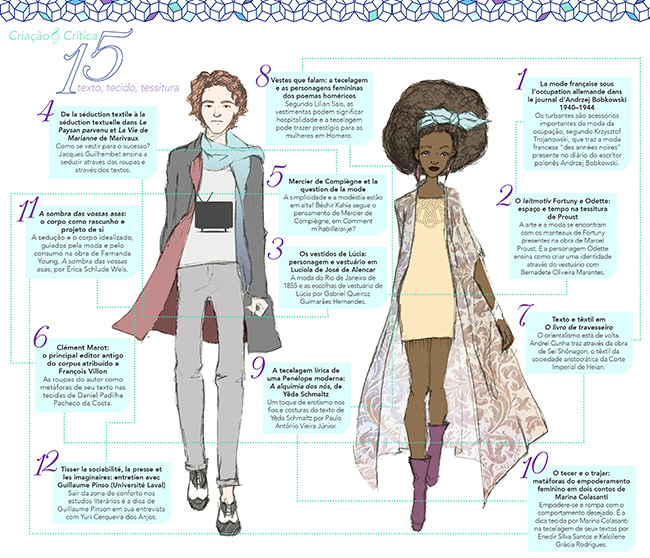O tecer e o trajar: metáforas do empoderamento feminino em dois contos de Marina Colasanti
DOI:
https://doi.org/10.11606/issn.1984-1124.v0i15p160-174Palavras-chave:
Literatura. Autoria Feminina. Tecer Narrativo. MetáforaResumo
Os contos de Marina Colasanti transitam entre o real e o fantástico alinhavando ações que conduzem as relações humanas e seus dilemas. Suas narrativas curtas são retiradas das experiências diárias para suscitar reflexões muito mais abrangentes, pois são entrelaçados de palavras e situações que desvelam o cotidiano e o comportamento exigido da mulher. A partir da análise dos contos “A moça tecelã”, do livro Doze reis e a moça no labirinto do vento (1982), e “Plano matrimonial”, de Contos do amor rasgado (1982), evidenciamos de que forma a autora constrói, metaforicamente, na tessitura narrativa a roupa masculina e o trabalho da tecelã para refletir acerca do empoderamento da mulher. Os contos têm em comum a relação heterossexual das protagonistas intermediada pelos trajes masculinos, que se revestem de simbologia e revelam, no contexto literário, a explanação do lugar social da mulher e do homem, visto como uma das linhas que alinhavam a vivência humana. Desse modo, Marina Colasanti tece na trama discursiva as redes de significações reveladoras do fazer e do ser feminino.
Downloads
Referências
ALMEIDA, L. Cozinhar é igual a tecer que é igual a narrar. Espéculo. Madri, n. 28, nov. 2004. Disponível em: <http://www.ucm.es/info/especulo/numero28/cozinhar.html. Acesso em: 15 jul. 2015.
BAKHTIN, M. Estética da criação verbal. Tradução de Paulo Bezerra. 6 ed. São Paulo: WMF Martins Fontes, 2011.
BRANDÃO, R. S. “O lugar do texto sobre o feminino”. In: CASTELLO BRANCO, L., BRANDÃO, R. S. A mulher escrita. Rio de Janeiro: Casa Maria Editorial: LTC, 1989. p. 21-24.
CAMPELLO, E. A tessitura da escrita: Do mito à expressão pela arte. Interdisciplinar, Piauí, Ano 3, v. 7, nº. 7, p. 43‐57, Jul/Dez de 2008. Disponível em: Acesso em: 15 jul 2015.
CANDIDO, A. Literatura e personagem. In: CANDIDO, A. et al. A personagem de ficção. São Paulo: Perspectiva, 1976. p. 51-80.
COLASANTI, M. Mulher daqui pra frente. São Paulo: Círculo do livro, 1981.
COLASANTI, M. E por falar em amor. São Paulo: Círculo do livro, 1984.
COLASANTI, M. Contos de amor rasgados. Rio de Janeiro: Rocco, 1986.
COLASANTI, M. O leopardo é um animal delicado. Rio de Janeiro: Rocco, 1998.
COLASANTI, M. Por que nos perguntam se existimos. In: SHARPE, P. Entre resistir e identificar-se: para uma teoria da prática da narrativa brasileira de autoria feminina. Florianópolis: Editora Mulheres; Goiânia: Editora da UFG, 1997. p. 33-42.
COLASANTI, Marina. “A moça tecelã”. In: _____. Doze reis e a moça no labirinto do vento. 10. ed. São Paulo: Global, 2001, p. 9-14.
DALCASTAGNÈ, R. Literatura brasileira contemporânea: um território contestado. Vinhedo: Editora Horizonte, 2012.
SHARPE, P. Imagens e poder: construindo a obra de Marina Colasanti. In: SHARPE, P. Entre resistir e identificar-se: para uma teoria da prática da narrativa brasileira de autoria feminina. Florianópolis: Editora Mulheres; Goiânia: Editora da UFG, 1997. p. 43-56.
XAVIER, E. Reflexões sobre a narrativa de autoria feminina. In: XAVIER, E. Tudo no feminino: a mulher e a narrativa brasileira contemporânea. Rio de Janeiro: Francisco Alves, 1991. p. 9-16.
Downloads
Publicado
Edição
Seção
Licença
Autores que publicam nesta revista concordam com os seguintes termos:
a. Autores mantém os direitos autorais e concedem à revista o direito de primeira publicação, com o trabalho simultaneamente licenciado sob a Licença Creative Commons Attribution que permite o compartilhamento do trabalho com reconhecimento da autoria e publicação inicial nesta revista.
b. Autores têm autorização para assumir contratos adicionais separadamente, para distribuição não-exclusiva da versão do trabalho publicada nesta revista (ex.: publicar em repositório institucional ou como capítulo de livro), com reconhecimento de autoria e publicação inicial nesta revista.
c. Autores têm permissão e são estimulados a publicar e distribuir seu trabalho online (ex.: em repositórios institucionais ou na sua página pessoal) a qualquer ponto antes ou durante o processo editorial, já que isso pode gerar alterações produtivas, bem como aumentar o impacto e a citação do trabalho publicado (Veja O Efeito do Acesso Livre).



